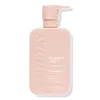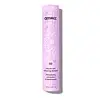What's inside
What's inside
 Key Ingredients
Key Ingredients

 Benefits
Benefits

 Concerns
Concerns

 Ingredients Side-by-side
Ingredients Side-by-side

Water
Skin ConditioningDisodium Laureth Sulfosuccinate
CleansingSodium C14-16 Olefin Sulfonate
CleansingCocamidopropyl Betaine
CleansingSodium Chloride
MaskingCocamidopropyl Hydroxysultaine
CleansingPEG-7 Glyceryl Cocoate
EmulsifyingGlycerin
HumectantCocamide Mipa
EmulsifyingPhenoxyethanol
PreservativeSodium Lauroyl Sarcosinate
CleansingPEG-120 Methyl Glucose Dioleate
EmulsifyingSodium Benzoate
MaskingParfum
MaskingCocos Nucifera Oil
MaskingCitric Acid
BufferingSodium PCA
HumectantBenzyl Alcohol
PerfumingEthylhexylglycerin
Skin ConditioningPolyquaternium-7
Hexyl Cinnamal
PerfumingDecyl Glucoside
CleansingSodium Sulfite
PreservativeLinalool
PerfumingTocopheryl Acetate
AntioxidantCoconut Acid
CleansingIsopropanolamine
BufferingTocopherol
AntioxidantCitrus Paradisi Fruit Extract
Skin ConditioningButylene Glycol
HumectantHydroxyacetophenone
AntioxidantWater, Disodium Laureth Sulfosuccinate, Sodium C14-16 Olefin Sulfonate, Cocamidopropyl Betaine, Sodium Chloride, Cocamidopropyl Hydroxysultaine, PEG-7 Glyceryl Cocoate, Glycerin, Cocamide Mipa, Phenoxyethanol, Sodium Lauroyl Sarcosinate, PEG-120 Methyl Glucose Dioleate, Sodium Benzoate, Parfum, Cocos Nucifera Oil, Citric Acid, Sodium PCA, Benzyl Alcohol, Ethylhexylglycerin, Polyquaternium-7, Hexyl Cinnamal, Decyl Glucoside, Sodium Sulfite, Linalool, Tocopheryl Acetate, Coconut Acid, Isopropanolamine, Tocopherol, Citrus Paradisi Fruit Extract, Butylene Glycol, Hydroxyacetophenone
Water
Skin ConditioningSodium C14-16 Olefin Sulfonate
CleansingPEG-120 Methyl Glucose Dioleate
EmulsifyingLauryl Betaine
CleansingGlycerin
HumectantPolysorbate 20
EmulsifyingLarix Europaea Wood Extract
HumectantHydrolyzed Rice Protein
Skin ConditioningHydrolyzed Vegetable Protein
Skin ConditioningVp/Dmapa Acrylates Copolymer
Hippophae Rhamnoides Seed Oil
Skin ProtectingSerenoa Serrulata Fruit Extract
Skin ConditioningUrtica Dioica Extract
AstringentMorus Alba Root Extract
BleachingCamellia Sinensis Leaf Extract
AntimicrobialGlycine
BufferingPouteria Sapota Seed Oil
EmollientPersea Gratissima Oil
Skin ConditioningSodium Phytate
Sodium Metabisulfite
AntioxidantZinc Chloride
AntimicrobialCitric Acid
BufferingPhenoxyethanol
PreservativeSodium Benzoate
MaskingParfum
MaskingSodium Chloride
MaskingDisodium EDTA
Sodium Hydroxide
BufferingBenzalkonium Chloride
AntimicrobialBenzyl Alcohol
PerfumingPotassium Sorbate
PreservativeButylphenyl Methylpropional
PerfumingHydroxycitronellal
PerfumingHydroxyisohexyl 3-Cyclohexene Carboxaldehyde
MaskingLimonene
PerfumingWater, Sodium C14-16 Olefin Sulfonate, PEG-120 Methyl Glucose Dioleate, Lauryl Betaine, Glycerin, Polysorbate 20, Larix Europaea Wood Extract, Hydrolyzed Rice Protein, Hydrolyzed Vegetable Protein, Vp/Dmapa Acrylates Copolymer, Hippophae Rhamnoides Seed Oil, Serenoa Serrulata Fruit Extract, Urtica Dioica Extract, Morus Alba Root Extract, Camellia Sinensis Leaf Extract, Glycine, Pouteria Sapota Seed Oil, Persea Gratissima Oil, Sodium Phytate, Sodium Metabisulfite, Zinc Chloride, Citric Acid, Phenoxyethanol, Sodium Benzoate, Parfum, Sodium Chloride, Disodium EDTA, Sodium Hydroxide, Benzalkonium Chloride, Benzyl Alcohol, Potassium Sorbate, Butylphenyl Methylpropional, Hydroxycitronellal, Hydroxyisohexyl 3-Cyclohexene Carboxaldehyde, Limonene
 Reviews
Reviews

Ingredients Explained
These ingredients are found in both products.
Ingredients higher up in an ingredient list are typically present in a larger amount.
Benzyl Alcohol is most commonly used as a preservative. It also has a subtle, sweet smell. Small amounts of Benzyl Alcohol is not irritating and safe to use in skincare products. Most Benzyl Alcohol is derived from fruits such as apricots.
Benzyl Alcohol has both antibacterial and antioxidant properties. These properties help lengthen the shelf life of products. Benzyl Alcohol is a solvent and helps dissolve other ingredients. It can also improve the texture and spreadability.
Alcohol comes in many different forms. Different types of alcohol will have different effects on skin. This ingredient is an astringent alcohol.
Using high concentrations of these alcohols are drying on the skin. They may strip away your skin's natural oils and even damage your skin barrier. Astringent alcohols may also irritate skin.
Other types of astringent alcohols include:
According to the National Rosacea Society based in the US, you should be mindful of products with these alcohols in the top half of ingredients.
Any type of sanitizing product will have high amounts of alcohol to help kill bacteria and viruses.
Learn more about Benzyl AlcoholCitric Acid is an alpha hydroxy acid (AHA) naturally found in citrus fruits like oranges, lemons, and limes.
Like other AHAs, citric acid can exfoliate skin by breaking down the bonds that hold dead skin cells together. This helps reveal smoother and brighter skin underneath.
However, this exfoliating effect only happens at high concentrations (20%) which can be hard to find in cosmetic products.
Due to this, citric acid is usually included in small amounts as a pH adjuster. This helps keep products slightly more acidic and compatible with skin's natural pH.
In skincare formulas, citric acid can:
While it can provide some skin benefits, research shows lactic acid and glycolic acid are generally more effective and less irritating exfoliants.
Most citric acid used in skincare today is made by fermenting sugars (usually from molasses). This synthetic version is identical to the natural citrus form but easier to stabilize and use in formulations.
Read more about some other popular AHA's here:
Learn more about Citric AcidGlycerin is already naturally found in your skin. It helps moisturize and protect your skin.
A study from 2016 found glycerin to be more effective as a humectant than AHAs and hyaluronic acid.
As a humectant, it helps the skin stay hydrated by pulling moisture to your skin. The low molecular weight of glycerin allows it to pull moisture into the deeper layers of your skin.
Hydrated skin improves your skin barrier; Your skin barrier helps protect against irritants and bacteria.
Glycerin has also been found to have antimicrobial and antiviral properties. Due to these properties, glycerin is often used in wound and burn treatments.
In cosmetics, glycerin is usually derived from plants such as soybean or palm. However, it can also be sourced from animals, such as tallow or animal fat.
This ingredient is organic, colorless, odorless, and non-toxic.
Glycerin is the name for this ingredient in American English. British English uses Glycerol/Glycerine.
Learn more about GlycerinParfum is a catch-all term for an ingredient or more that is used to give a scent to products.
Also called "fragrance", this ingredient can be a blend of hundreds of chemicals or plant oils. This means every product with "fragrance" or "parfum" in the ingredients list is a different mixture.
For instance, Habanolide is a proprietary trade name for a specific aroma chemical. When used as a fragrance ingredient in cosmetics, most aroma chemicals fall under the broad labeling category of “FRAGRANCE” or “PARFUM” according to EU and US regulations.
The term 'parfum' or 'fragrance' is not regulated in many countries. In many cases, it is up to the brand to define this term.
For instance, many brands choose to label themselves as "fragrance-free" because they are not using synthetic fragrances. However, their products may still contain ingredients such as essential oils that are considered a fragrance by INCI standards.
One example is Calendula flower extract. Calendula is an essential oil that still imparts a scent or 'fragrance'.
Depending on the blend, the ingredients in the mixture can cause allergies and sensitivities on the skin. Some ingredients that are known EU allergens include linalool and citronellol.
Parfum can also be used to mask or cover an unpleasant scent.
The bottom line is: not all fragrances/parfum/ingredients are created equally. If you are worried about fragrances, we recommend taking a closer look at an ingredient. And of course, we always recommend speaking with a professional.
Learn more about ParfumPeg-120 Methyl Glucose Dioleate is used to improve texture and stability of a product. It is sugar based and helps thicken a product.
Once applied, it also creates a thin film to trap moisture in. This helps keep your skin hydrated.
This ingredient is the polyethylene glycol ether of the diester of oleic acid and methylglucose. The 120 represents an average of 120 moles of ethylene oxide.
There is limited research on this ingredient, although it is considered safe to use in skincare products.
Learn more about PEG-120 Methyl Glucose DioleatePhenoxyethanol is a preservative that has germicide, antimicrobial, and aromatic properties. Studies show that phenoxyethanol can prevent microbial growth. By itself, it has a scent that is similar to that of a rose.
It's often used in formulations along with Caprylyl Glycol to preserve the shelf life of products.
Sodium Benzoate is a preservative. It's used in both cosmetic and food products to inhibit the growth of mold and bacteria. It is typically produced synthetically.
Both the US FDA and EU Health Committee have approved the use of sodium benzoate. In the US, levels of 0.1% (of the total product) are allowed.
Sodium benzoate works as a preservative by inhibiting the growth of bacteria inside of cells. It prevents the cell from fermenting a type of sugar using an enzyme called phosphofructokinase.
It is the salt of benzoic acid. Foods containing sodium benzoate include soda, salad dressings, condiments, fruit juices, wines, and snack foods.
Studies for using ascorbic acid and sodium benzoate in cosmetics are lacking, especially in skincare routines with multiple steps.
We always recommend speaking with a professional, such as a dermatologist, if you have any concerns.
Learn more about Sodium BenzoateSodium C14-16 Olefin Sulfonate is a cleansing agent made from a mixture of long chain sulfonate salts. It can also help produce foam.
This ingredient may be drying. We recommend speaking with a professional if you have concerns.
Chances are, you eat sodium chloride every day. Sodium Chloride is also known as table salt.
This ingredient has many purposes in skincare: thickener, emulsifier, and exfoliator.
You'll most likely find this ingredient in cleansers where it is used to create a gel-like texture. As an emulsifier, it also prevents ingredients from separating.
There is much debate on whether this ingredient is comedogenic. The short answer - comedogenic ratings don't tell the whole story. Learn more about comegodenic ratings here.
The concensus about this ingredient causing acne seems to be divided. Research is needed to understand if this ingredient does cause acne.
Scrubs may use salt as the primary exfoliating ingredient.
Learn more about Sodium ChlorideWater. It's the most common cosmetic ingredient of all. You'll usually see it at the top of ingredient lists, meaning that it makes up the largest part of the product.
So why is it so popular? Water most often acts as a solvent - this means that it helps dissolve other ingredients into the formulation.
You'll also recognize water as that liquid we all need to stay alive. If you see this, drink a glass of water. Stay hydrated!
Learn more about Water